
Parvati, also known as Uma and Gauri, is one of the principal goddesses in Hinduism, revered as the goddess of power, energy, nourishment, harmony, love, beauty, devotion, and motherhood. Along with Lakshmi and Sarasvati, she forms the trinity, known as the Tridevi.
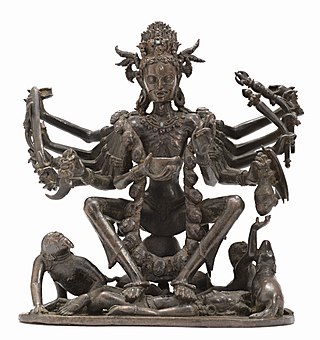
Chamunda, also known as Chamundeshwari, Chamundi or Charchika, is a fearsome form of Chandi, the Hindu mother goddess, Mahadevi and is one of the seven Matrikas.

Shaktism is a major Hindu denomination in which the deity or metaphysical reality is considered metaphorically to be a woman.
Singheshwar is one of the administrative divisions of Madhepura district in the Indian state of Bihar. The block headquarters are located at a distance of 6 km from the district headquarters, namely, Madhepura. There's a temple of Lord Shiva. Devotees come from many places for puja. In month of Saavan Singheshwar is jam packed by people. People from Nepal also come for puja.
Barpali is a small town and a block (Tehsil) within the Bargarh district in the state of Odisha, India. Barpali is largely famous for renowned Odia Poet Swabhaba Kabi Gangadhar Meher who was born here. However, there are several other cultural notations which have made Barpali famous nationally and internationally, like: the indigenous sambalpuri saree weaving art and the earthen pottery handicrafts (Terracotta) etc, creations from the native inhabitants of Barpali. Among others, the name Barpali also draws attention towards the past studies, wide usage and then outward expansion of preliminary versions of sanitary toilets started by foreigners here, known as 'Barpali Toilets' nearly 40 years ago.
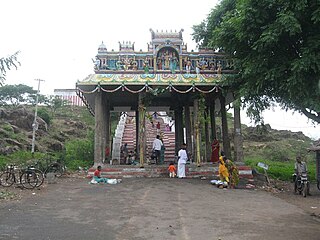
Kundrathur is a town located in the Chennai Metropolitan Area and the headquarters of Kundrathur taluk in Kanchipuram District. It is the birthplace of Sekkizhar, a well-known poet-saint who authored the Periyapuranam.
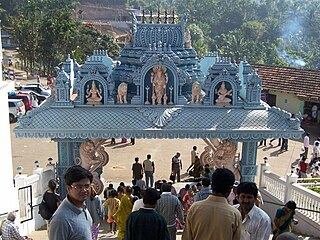
The Annapoorneshwari Temple is a Hindu temple dedicated to the goddess Annapoorneshwari (Annapoorna), located at Horanadu, Karnataka, India, 100 km from Chikmagalur in the thick forests and valleys of the Western Ghats of Karnataka. It is situated on the banks of river Bhadra.

Thirumandhamkunnu Temple is a historically significant Hindu temple in Angadipuram, which was the capital of Valluvanad Rajavamsham, in Malappuram district, Kerala state, South India. The temple deity, Thirumandhamkunnil amma, was the paradevatha of the kings of Valluvanad, the local feudal kings ruled the area in the Middle Ages. The Nair warriors of Valluvanad king set out from this temple to Thirunavaya, to participate in the famous Mamankam festival. A memorial structure called the chaver thara can be found in front of the main entrance of the Thirumanthamkunnu Temple.

Akhilandeshwari is one of the main forms of the Hindu Goddess Adi Parashakti. The famous abode of Akhilandeshwari is the Jambukeswarar Temple in Thiruvanaikaval. She is also revered collectively with the goddesses Meenakshi and Kamakshi, forming the Trishakti triad, the most powerful goddesses in Shaktism. The goddess’s name is split into three components. “Akhila” means the universe, “Anda” means cosmic egg, and “Ishwari” means the divine mother. Therefore, Goddess, the divine mother who protects the entire universe in her womb, is known as “Akhilandeshwari”. Akhilandeshwari is the presiding deity in the Jambukeswarar Temple in Thiruvanaikaval along with her consort Jambukeswarar, who is an avatar of Shiva.
This article lists the traditional festivals and other cultural events in the Odisha region of India. Odisha celebrates 13 festivals in 12 months as the saying goes Bāra Māsare Tera Parba.

Thenupuriswarar Temple is a Hindu temple dedicated to the god Shiva located in the village of Patteeswaram, Tamil Nadu, India. Shiva is worshiped as Thenupuriswarar, and is represented by the lingam. His consort Parvati is depicted as Nyanambikai (Somakamalambigai). The presiding deity is revered in the 7th century Tamil Saiva canonical work, the Tevaram, written by Tamil saint poets known as the Nayanars and classified as Paadal Petra Sthalam. The temple is associated with the legend of Sambandar to whose view Nandi moved to have a direct view of the presiding deity. Muthupandal festival celebrated in the temple in associated with the legend.
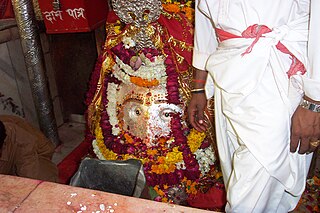
Kalkaji Mandir, is a Hindu Temple, dedicated to the Hindu Goddess Kali. It is situated in southern Delhi, in Kalkaji, India, a locality that has derived its name from the temple and is located opposite the Nehru Place and close to the Okhla railway station, Kalkaji Mandir metro station. Hindus believe that the image of the Goddess Kalka here is a self-manifested one.

Kali, also called Kalika, is a major goddess in Hinduism, primarily associated with time, death and destruction. The origins of Kali can be traced to the pre-Vedic and Vedic era Goddess worship traditions in Ancient India. Kali is the first of the ten Mahavidyas in the Hindu tantric tradition and is the supreme deity in the Kalikula worship tradition.

Navaratri is an annual Hindu festival observed in honor of the goddess Durga, an aspect of Adi Parashakti, the supreme goddess. For Shaivites and Shaktas, Durga is a form or actually is Goddess Parvati. It spans over nine nights, first in the month of Chaitra, and again in the month of Ashvin (September–October). It is observed for different reasons and celebrated differently in various parts of the Hindu Indian cultural sphere. Theoretically, there are four seasonal Navaratris. However, in practice, it is the post-monsoon autumn festival called Sharada Navaratri. There are 2 Gupta Navaratris or "Secret Navaratris" as well, one starting on the Shukla Paksha Pratipada of the Magha Month and another starting in the Shukla Paksha Pratipada of Ashadha Month.

Kalaratri is the seventh of the nine Navadurga forms of the goddess Mahadevi. She is first referenced in the Devi Mahatmya. Kalaratri is one of the fearsome forms of the goddess.

Chittaranjan Park Kali Mandir is a Hindu temple and Bengali community cultural center in Chittaranjan Park in New Delhi, India. Built on a small hill, it started as a Shiv temple in 1973, which still stands within the complex, the larger shrines dedicated to goddess Kali, Shiva, and Radhakrishna were added in 1984. Over the years it has remained an important centre of convergence of local Bengali community during annual Durga Puja festivities. The temple also hosted its first Durga Puja in 1977, a tradition that continues to date.
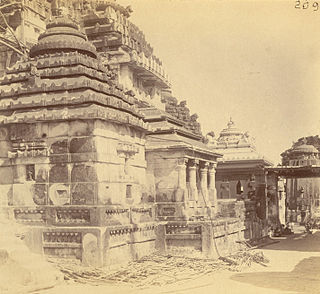
The Vimala Temple or Bimala Temple is a Hindu temple dedicated to goddess Vimala or Bimala (ବିମଳା), located within the Jagannath Temple complex in Puri in the Indian state of Odisha. It is generally regarded as a Shakta pitha, among the holiest temples dedicated to the Hindu Goddess.

Maheswarnath Mandir is a Hindu temple located in the town of Triolet, Mauritius. The presiding deity of the temple is Lord Shiva. The temple was founded in 1888 by Pandit Shri Sajeebunlall Ramsoondur, who came from Calcutta. The temple is famous for its association with the first pilgrimage to Ganga Talao, the sacred lake found in the center of Mauritius. The temple is the biggest and one of the oldest Hindu temples on the island along with the Kovil at Bon Espoir Piton (1830), Sinatambou Kovil at Terre Rouge (1850), Murugan Kovil at Clemencia (1856), the Shivala at Gokoolah (1867), Rameshwarnath Shivala at Terre Rouge (1867) and Jharnath Shivala at l'Aventure (1881). There also old Mandaps and Kalimayes dedicated to Durga and Kali, like the one at Antoinette Phooliyar and a Durga Mandap at Cinema Casse in Triolet itself (1882).
Kali Bari Chhindwara is a temple dedicated to Goddess Kali and the center of Bengali culture in Chhindwara, India. Established in 1995, the deity in the temple is Maa Kali.

Jag Janani Maa Vaishno Devi – Kahani Mata Rani Ki, is an Indian mythological television series, which premiered on 30 September 2019 on Star Bharat. It is based on the life of Goddess Vaishno Devi. The series is produced by Rashmi Sharma and Pawan Kumar Marut under Rashmi Sharma Telefilms. The show aired its last episode on 2 October 2020.
















